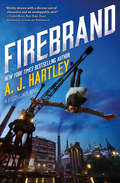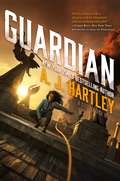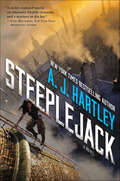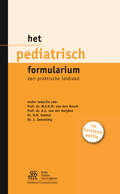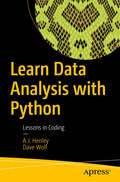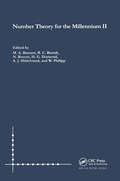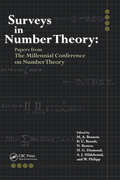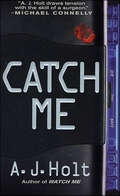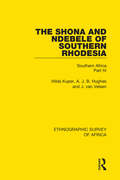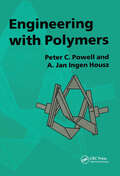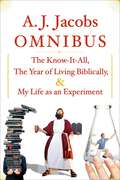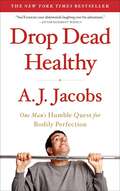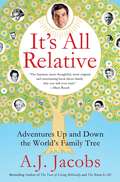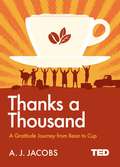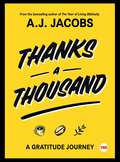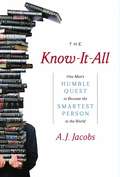- Table View
- List View
Darwen Arkwright and the School of Shadows
by A. J. HartleyThe third book in the quirky and enchanting Darwen Arkwright series, perfect for fans of The Mysterious Benedict Society! THE FIGHT FOR BOTH OUR WORLDS MUST COME TO AN END. Mr. Peregrine has been kidnapped! Now it's up to Darwen, Rich, and Alexandra to rescue him. They'll embark upon a journey that will take them deeper into Silbrica than they've ever gone before, and there, on the other side of the mirror, they'll find the strangest sight of all: an exact replica of Hillside Academy. This is only the first of many connections that Darwen and his friends are about to discover between the human world and the world of Silbrica. And as the connections begin piling up, they'll be forced to confront the most horrifying realization of all: they've been lied to this entire time.
Firebrand: A Steeplejack Novel
by A. J. HartleyNew York Times bestselling author A. J. Hartley returns to his intriguing, 19th-century South African-inspired fantasy world in Firebrand, another adrenaline-pounding adventure.Once a steeplejack, Anglet Sutonga is used to scaling the heights of Bar-Selehm. Nowadays she assists politician Josiah Willinghouse behind the scenes of Parliament. The latest threat to the city-state: Government plans for a secret weapon are stolen and feared to be sold to the rival nation of Grappoli. The investigation leads right to the doorsteps of Elitus, one of the most exclusive social clubs in the city. In order to catch the thief, Ang must pretend to be a foreign princess and infiltrate Elitus. But Ang is far from royal material, so Willinghouse enlists help from the exacting Madam Nahreem. Yet Ang has other things on her mind. Refugees are trickling into the city, fleeing Grappoli-fueled conflicts in the north. A demagogue in Parliament is proposing extreme measures to get rid of them, and she soon discovers that one theft could spark a conflagration of conspiracy that threatens the most vulnerable of Bar-Selehm. Unless she can stop it."Richly-drawn with a diverse cast of characters and an unstoppable plot!” – Carrie Ryan, New York Times bestselling author, on SteeplejackAt the Publisher's request, this title is being sold without Digital Rights Management Software (DRM) applied.
Guardian: Book 3 in the Steeplejack series (Steeplejack #3)
by A. J. HartleyIn A. J. Hartley’s thrilling and intriguing 19th-century South African-inspired fantasy world, which started with the Thriller Award-winning Steeplejack and continues with Guardian, Anglet Sutonga is a teenage detective fighting in a race against time as her beloved city is pushed to the brink.This is what Ang knows: A dear friend is accused of murdering the Prime Minister of Bar-Selehm.A mysterious but fatal illness is infecting the poor. A fanatical politician seizes power, unleashing a wave of violent repression over the city. This is what Ang must do: Protect her family.Solve a murder.RESIST, no matter what, before it’s too late.“Richly-drawn and diverse cast of characters, with an unstoppable plot!” —Carrie Ryan, New York Times bestselling author“Smart political intrigue wrapped in all the twists and turns of a good detective story.” — Kirkus Reviews,starred review“A political, multilayered mystery-thriller with a strong, impressively fierce heroine.” —Shelf Awareness, starred reviewAt the Publisher's request, this title is being sold without Digital Rights Management Software (DRM) applied.
La máscara de Atreo
by A. J. HartleyAventura, misterio, historia, mitos y leyendas. Un thriller arqueológico absorbente. El fundador de un pequeño museo en Atlanta aparece asesinado en la cámara secreta donde guardaba una sorprendente colección de antigüedades griegas, cuya existencia había estado ocultando incluso a sus colaboradores más inmediatos. Parece que únicamente una pieza arqueológica, la más valiosa, ha desaparecido: una máscara de oro, supuestamente del legendario rey Atreo. Y todo indica que procedía del tesoro que, en el siglo XIX, desenterró el arqueólogo alemán Heinrich Schliemann, el hombre cuya pasión por la Ilíada le llevó a descubrir los restos de Troya y de Micenas. Cuando Deborah Miller, la conservadora del museo, ve amenazada su vida, se pone sobre la pista de esta máscara, que la conducirá a la historia y los escenarios de las excavaciones de Schliemann, pero también a un «tesoro» más oscuro y peligroso de lo que habíaimaginado. Algunos secretos deberían permanecer por siempre enterrados. «Llena de detalles históricos y arqueológicos, esta absorbente y compleja novela augura un prometedor futuro a A. J. Hartley.» Publishers Weekly
Steeplejack: A Novel (Steeplejack #1)
by A. J. HartleyThoughtfully imaginative and action-packed, Steeplejack is New York Times bestselling A. J. Hartley's YA debut set in a 19th-century South African fantasy world“A richly realized world, an intensely likable character, and a mystery to die for." — Cory Doctorow, New York Times-bestselling authorSeventeen-year-old Anglet Sutonga lives and works as a steeplejack in Bar-Selehm, a sprawling city known for its great towers, spires, and smokestacks – and even greater social disparities across race and class. Ang’s world is turned upside-down when her new apprentice Berrit is murdered the same night that the city’s landmark jewel is stolen. Her search for answers behind his death exposes unrest in the streets and powerful enemies. But she also finds help from unexpected friends: a kindhearted savannah herder, a politician’s haughty sister, and a savvy newspaper girl. As troubles mount in Bar-Selehm, Ang must discover the truth behind both murder and theft soon – or else watch the city descend into chaos.YALSA Best Fiction for Young Adults Selection Kirkus Reviews Best Teen Book Booklist Top Ten YA in Science Fiction, Fantasy and HorrorAt the Publisher's request, this title is being sold without Digital Rights Management Software (DRM) applied.
Het pediatrisch formularium
by W.J.H.M. Bosch A. J. Heijden R. N. Sukhai J. ZwavelingBij het beschrijven van de gezondheid en ziekte van kinderen, uitgaande van de dagelijkse praktijk is gekozen voor verschillende ingangen. Enerzijds vanuit de klachten waarmee kinderen (en hun ouders) zich presenteren en anderzijds met de ziekte of het syndroom als uitgangspunt. Verder komt naast spoedeisende problemen de zorg voor de pasgeborene en de ontwikkeling van kinderen aan de orde. In deze 5e editie Alle hoofdstukken zijn voor deze 5e editie gereviseerd en waar nodig geactualiseerd. Er zijn twee hoofdstukken toegevoegd, een over gedragsproblemen bij kinderen waaronder ADHD en een over ernstige bacteriële infecties zoals de meningokokkenziekte. Bij de adviezen over voorschrijven en doseren van geneesmiddelen bij kinderen is in deze uitgave gebruik gemaakt van Het Kinderformularium (www. kinderformularium. nl).
Java EE Web Application Primer
by Dave Wolf A. J. HenleyBuild an online messaging app using Java Servlets, JSP, Expression Language, JSTL, JPQL, Sessions/Cookies, HTML/CSS/JavaScript, and the Bootstrap framework. This book explains Java EE, along with its associated technologies making it perfect for those with at least basic programming experience in Java or C. Java EE Web Application Primer teaches you how to develop complete web applications using Oracle as the database. By the end of the book you will have developed an online messaging app like Twitter. From there you can create other applications such as an online survey tool. What You'll Learn Build a Twitter-like web application called Bullhorn using Java, Oracle, and more Create web applications using Eclipse Design web pages with HTML forms, tables, and more Use SQL along with Java and Oracle for database accessibility Connect to a database using the Java Persistence APIs Create dynamic web pages with JavaScript, JSP, and the tag libraries Get web pages to stand out with Bootstrap, jQuery, and CSS Who This Book Is For Those with at least basic programming experience in Java or C.
Learn Data Analysis with Python: Lessons In Coding
by Dave Wolf A. J. HenleyGet started using Python in data analysis with this compact practical guide. This book includes three exercises and a case study on getting data in and out of Python code in the right format. Learn Data Analysis with Python also helps you discover meaning in the data using analysis and shows you how to visualize it. Each lesson is, as much as possible, self-contained to allow you to dip in and out of the examples as your needs dictate. If you are already using Python for data analysis, you will find a number of things that you wish you knew how to do in Python. You can then take these techniques and apply them directly to your own projects.If you aren’t using Python for data analysis, this book takes you through the basics at the beginning to give you a solid foundation in the topic. As you work your way through the book you will have a better of idea of how to use Python for data analysis when you are finished.What You Will LearnGet data into and out of Python codePrepare the data and its formatFind the meaning of the dataVisualize the data using iPythonWho This Book Is For Those who want to learn data analysis using Python. Some experience with Python is recommended but not required, as is some prior experience with data analysis or data science.
Global Reach: Revolutionizing The Use Of Commercial Vessels And Intermodal Systems For Military Sealift, 1990-2012
by A. J. Herberger Ken Gaulden Rolf MarshallGlobal Reach presents a unique view of the fiscal constraints facing the Department of Defense and the U. S. Government. It calls for U. S. policymakers and the general public to understand the message within the book. With this understanding, the United States will ensure its future ability to acquire and maintain the sealift capability to respond to these challenges in the years to come. The twenty years following the Persian Gulf Conflict (1990-91) saw a revolution in the means by which the United States military deploys and sustains U. S. armed forces worldwide during contingencies. Historically, 95 percent of the equipment and supplies our military needs to fight and win in combat are delivered by ship. That remains true today. What has changed is how those cargoes are delivered in theater. For almost as long as nations sought to deploy military forces by sea, they relied on commercial "Ships Taken Up From Trade” to meet those needs. This changed for the United States with the global conflicts of the twentieth-century. With millions of troops deployed oversea and the need to simultaneously supply allied nations with tools of war and food and supplies for their civil economies, the need for sealift exceeded what the commercial fleet could supply. For the First and Second World Wars, America’s mobilization including the construction of thousands of government-owned merchant type ships for sealift. This Government-owned fleet model remained the general practice after 1945 as U. S. forces during both the Korean and Vietnam conflicts were in large part deployed and supplied by the same ships as had supported the Allied victories in Europe and the Pacific. The Persian Gulf Conflict signaled a need for change. Not only had the nature of the conflicts changed, but so too had the commercial maritime industry in the United States and worldwide. Working in close cooperation with its commercial industry partners, including carriers and maritime labor, the U. S. military over the next decade revolutionized the use of commercial vessels and intermodal systems for military sealift. By 2002, the then Commander of the U. S. Transportation Command, General John W. Handy, USAF, in testimony before the U. S. Congress stated that "[w]e simply cannot, as a nation, fight the fight without the partnership of the commercial maritime industry. ” By 2009-10, not only was 95 percent of all equipment and supplies required by U. S. forces in Iraq and Afghanistan still being delivered by ship, but over 90 percent of those cargoes were being transported by United States-flag commercial vessels and U. S. citizen crews in regular commercial liner services. This is the story of that revolution in military sealift.
Water Waves and Ship Hydrodynamics: An Introduction
by A. J. HermansIn this book an introduction is given to aspects of water waves that play a role in ship hydrodynamics and offshore engineering. At first the equations and linearized boundary conditions are derived describing the non-viscous free surface water waves, with special attention to the combination of steady and non-steady flow fields. Then some simple kinds of free wave solutions are derived, such as plane waves and cylindrical waves. For several situations, steady and unsteady, the source singularity function is derived. These functions play a role in numerical codes used to describe the motion of ships and offshore structures. These codes are mostly based on a boundary integral formulation; therefore we give an introduction to these methods. It is shown how first order ship motions can be determined. In offshore engineering the second order wave drift motions play an important role. An introduction to this phenomenon is given and the effects which have to be taken into account are explained by means of a simple example where we can determine nearly all the aspects analytically. An interesting example that is worked out is the motion of very large floating flexible platforms with finite draft. Finally an introduction to the theory of shallow water non-linear dispersive waves is presented, and shallow water ship hydrodynamics, that plays a role in coastal areas and channels is treated. Here attention is paid to the interaction between passing ships in restricted water. In the appendix a short introduction to some of the mathematical tools is given.
Number Theory for the Millennium II
by M. A. Bennett N. Boston H. G. Diamond A. J. Hildebrand B. C. Berndt W PhilippBuilding on the tradition of an outstanding series of conferences at the University of Illinois at Urbana-Champaign, the organizers attracted an international group of scholars to open the new Millennium with a conference that reviewed the current state of number theory research and pointed to future directions in the field. The conference was the largest general number theory conference in recent history, featuring a total of 159 talks, with the plenary lectures given by George Andrews, Jean Bourgain, Kevin Ford, Ron Graham, Andrew Granville, Roger Heath-Brown, Christopher Hooley, Winnie Li, Kumar Murty, Mel Nathanson, Ken Ono, Carl Pomerance, Bjorn Poonen, Wolfgang Schmidt, Chris Skinner, K. Soundararajan, Robert Tijdeman, Robert Vaughan, and Hugh Williams. The Proceedings Volumes of the conference review some of the major number theory achievements of this century and to chart some of the directions in which the subject will be heading during the new century. These volumes will serve as a useful reference to researchers in the area and an introduction to topics of current interest in number theory for a general audience in mathematics.
Surveys in Number Theory: Papers from the Millennial Conference on Number Theory
by M. A. Bennett N. Boston H. G. Diamond A. J. Hildebrand B. C. Berndt W PhilippThis volume, based on fourteen papers from the Millennial Conference on Number Theory, represents surveys of topics in number theory and provides an outlook into the future of number theory research. It serves as an inspiration to graduate students and as a reference for research mathematicians.
Catch Me (Jay Fletcher Thrillers)
by A. J. HoltEx-FBI Agent Jay Fletcher -- "one of the most interesting female characters to come along in suspense fiction for quite some time" (Chicago Tribune) -- is in the Witness Security Program, trying to forget all about "Billy Bones", the tabloid name for a notorious serial killer. Her vigilante pursuit of Billy and other killers landed him in a hospital for the criminally insane -- and permanently ended Jay's law-enforcement career. Or so she thought. Now Billy is on the loose and e-mails a challenge: Catch me if you can. Unless his nemesis Jay is brought out of hiding and assigned to the case, he will begin a terrifying killing spree. Can Jay muster up her old manhunting skills and catch a killer before he catches her? A.J. Holt delivers another spine-tingling thriller that takes you into the mind of a madman.
The Shona and Ndebele of Southern Rhodesia: Southern Africa Part IV
by Hilda Kuper A. J. Hughes J. van VelsenRoutledge is proud to be re-issuing this landmark series in association with the International African Institute. The series, published between 1950 and 1977, brings together a wealth of previously un-co-ordinated material on the ethnic groupings and social conditions of African peoples. Concise, critical and (for its time) accurate, the Ethnographic Survey contains sections as follows: Physical Environment Linguistic Data Demography History & Traditions of Origin Nomenclature Grouping Cultural Features: Religion, Witchcraft, Birth, Initiation, Burial Social & Political Organization: Kinship, Marriage, Inheritance, Slavery, Land Tenure, Warfare & Justice Economy & Trade Domestic Architecture Each of the 50 volumes will be available to buy individually, and these are organized into regional sub-groups: East Central Africa, North-Eastern Africa, Southern Africa, West Central Africa, Western Africa, and Central Africa Belgian Congo. The volumes are supplemented with maps, available to view on routledge.com or available as a pdf from the publishers.
Engineering with Polymers, 2nd Edition
by P. C. Powell A. J. Ingen HouszPlastics and rubber materials, or polymers, are increasingly the first choice of engineers when reliable, cost-effective performance and safety are essential. The volume of polymers used in the Western economy now exceeds that of metals, which requires today's engineering students to have a thorough grounding in the properties and applications of polymeric materials. The first chapters of Engineering with Polymers explain what polymers are, how they behave, and how articles are made from them. The authors then show how the standard engineering techniques of stress analysis, structures, fluid mechanics, heat transfer and design can be adopted or adapted to cover plastics and rubber materials. The book ends with chapters detailing interactions between processing and properties, and a description of a variety of approaches to designing plastics products, from practical advice to the use or further development of theoretical principles, backed up by examples and case studies. The book is aimed at mechanical engineering students and design engineers in industry and also at materials' and chemical engineers.
A.J. Jacobs Omnibus: The Know-It-All, The Year of Living Biblically, My Life as an Experiment
by A. J. JacobsAn eBook boxed set that features the first three of A.J. Jacobs's riotous--and surprisingly informative--ventures into experiential journalism. The Know-It-All: Puzzle along with A.J. as he endeavors to read--and retain--the entire encyclopedia, and discover what exactly it is he learns along the way. The Year of Living Biblically: Discover what life would be like in the 21st century if you lived precisely by the dictates of the Bible--the insights gained about religion might surprise you. My Life as an Experiment: Join A.J. on a roller-coaster tour of life as a human guinea pig: he explores both the perks and pitfalls of various undertakings in a series of charming essays, including those titled "My Outsourced Life" and "My Life as a Beautiful Woman."
Automotive FDI in Emerging Europe: Shifting Locales in the Motor Vehicle Industry
by A. J. JacobsThis book examines the dramatic increase in automotive assembly plants in the former Socialist Central European (CE) nations of Czechia, East Germany, Hungary, Poland, and Slovakia from 1989 onwards. Enticed by relatively lower-wage labour and significant government incentives, the world's largest automakers have launched more than 20 passenger car assembly complexes in CE nations, with production accelerating dramatically since 2001. As a result, the annual passenger car production in Western Europe declined by more than 20% between 2001 and 2015, and alternatively in the CEE it increased by nearly 170% during this period. Drawing on case studies of 25 current and former foreign-run assembly plants, the author presents a rare historical account of automotive foreign assembly plants in the CE following this dramatic geographic shift. This book will expand the knowledge of policy-makers in Europe in relation to their pursuits of FDI and will be of great interest to scholars and students of business, economic history, political science, and development.
Drop Dead Healthy: One Man's Humble Quest for Bodily Perfection
by A. J. JacobsFrom the bestselling author of The Year of Living Biblically and The Know-It-All comes the true and truly hilarious story of one person's quest to become the healthiest man in the world. Hospitalized with a freak case of tropical pneumonia, goaded by his wife telling him, "I don't want to be a widow at forty-five," and ashamed of a middle-aged body best described as "a python that swallowed a goat," A.J. Jacobs felt compelled to change his ways and get healthy. And he didn't want only to lose weight, or finish a triathlon, or lower his cholesterol. His ambitions were far greater: maximal health from head to toe. The task was epic. He consulted an army of experts-- sleep consultants and sex clinicians, nutritionists and dermatologists. He subjected himself to dozens of different workouts--from Strollercize classes to Finger Fitness sessions, from bouldering with cavemen to a treadmill desk. And he took in a cartload of diets: raw foods, veganism, high protein, calorie restriction, extreme chewing, and dozens more. He bought gadgets and helmets, earphones and juicers. He poked and he pinched. He counted and he measured. The story of his transformation is not only brilliantly entertaining, but it just may be the healthiest book ever written. It will make you laugh until your sides split and endorphins flood your bloodstream. It will alter the contours of your brain, imprinting you with better habits of hygiene and diet. It will move you emotionally and get you moving physically in surprising ways. And it will give you occasion to reflect on the body's many mysteries and the ultimate pursuit of health: a well-lived life.
It's All Relative: Adventures Up and Down the World's Family Tree
by A. J. Jacobs#1 New York Times bestselling author A.J. Jacobs undergoes a hilarious, poignant quest to understand what constitutes family—where it begins and how far it goes—in It&’s All Relative, a &“thought-provoking…delightful, easy-to-read, informative book&” (Kirkus Reviews, starred review).A.J. Jacobs has received some strange emails over the years, but this note was perhaps the strangest: &“You don&’t know me, but I&’m your eighth cousin. And we have over 80,000 relatives of yours in our database.&” That&’s enough family members to fill Madison Square Garden four times over. Who are these people, A.J. wondered, and how do I find them? So began Jacobs&’s three-year adventure to help build the biggest family tree in history. In It&’s All Relative, he &“muses on the nature of family and the interconnectedness of humanity in this entertaining introduction to the world of genealogy&” (Publishers Weekly). Jacobs&’s journey would take him to all seven continents. He drank beer with a US president, sung with the Mormon Tabernacle Choir, and unearthed genetic links to Hollywood actresses and real-life scoundrels. After all, we can choose our friends, but not our family. &“Whether he&’s posing as a celebrity, outsourcing his chores, or adhering strictly to the Bible, we love reading about the wacky lifestyle experiments of author A.J. Jacobs&” (Entertainment Weekly). Now Jacobs upends, in ways both meaningful and hilarious, our understanding of genetics and genealogy, tradition and tribalism, identity and connection. &“Whimsical but also full of solid journalism and eye-opening revelations about the history of humanity, It&’s All Relative is a real treat&” (Booklist, starred review).
Thanks A Thousand: A Gratitude Journey (TED 2)
by A. J. JacobsBestselling author A.J. Jacobs has undergone a life-changing and entertaining journey. The idea is deceptively simple: he takes one of our greatest pleasures- our morning cup of coffee - and tries to thank every single person involved in making it, from the barista to the coffee farmer and all those in between. This turns out to be a stunningly large number, including artists, chemists, presidents, mechanics, biologists, miners, smugglers and goatherds. Hundreds of people. Thousands. Maybe more. Through this seemingly straightforward quest, Jacobs reveals inspiring truths. The book is a reminder of the amazing interconnectedness of our world. It shows us how much we take for granted. It teaches us how gratitude can make our lives happier, kinder and more impactful. And it will inspire readers to follow their own "Gratitude Trails." Gratitude was not an emotion that came easily to Jacobs. His innate disposition is more Larry David than Tom Hanks. But he knew that gratitude is perhaps the most important key to human happiness, the chief of all virtues, as Cicero said. Science has shown gratitude’s benefits are legion: it helps you sleep, improves your diet, and makes you more likely to recover from illnesses. Jacobs wanted to inspire his kids to embrace gratitude, so he decided to commit himself to a radical experiment. Over the course of several months, Jacobs went on a journey that took him across continents and up and down the social ladder. He experienced joy, wonder, guilt and depression. He met great characters. He learned just how far-flung are those involved – from the Minnesota miners who get the iron that makes the steel that makes the coffee roasters, to the Madison Avenue marketers who captured his wandering attention for a moment. His adventures include: A trip to a remote farm in Colombia, where he experienced first-hand how challenging it is to pick the coffee fruits. Several days with a coffee taster who taught Jacobs the secrets of the trade, and schooled him in the vocabulary that rivals wine sommeliers. (The taster doesn’t just detect notes of apple in his coffee. He says what kind of apple -- Gala? Honeycrisp?) Because coffee is 98.4 percent water, Jacobs visited the vast upstate reservoirs that supply New York City, and thanked the folks whose homes were destroyed to make way for the lakes. Jacobs devotes a chapter on the cup-makers, including the rags-to-riches inventor of the “Java Jacket,” that underappreciated cardboard ring you slip over your cup. It has saved millions of fingers and thumbs from burning discomfort, but we never give it a second thought. The food safety inspectors, who keep our coffee free from an alarming number of diseases and creatures. Along with entertaining tales, the book is filled with wonderful insights and useful tips. Readers learn how to focus on the hundreds of things that go right every day instead of the handful that go wrong. They read about our culture’s dangerous overemphasis on individuals instead of teams. They learn the art of “savouring meditation”. They learn the pros and cons of globalism. They learn to appreciate the astounding work it takes to create even the most simple items in our lives. There’s even a gratitude hack to help them fall asleep.
Thanks A Thousand: A Gratitude Journey (TED Books)
by A. J. JacobsThe idea was deceptively simple: New York Times bestselling author A.J. Jacobs decided to thank every single person involved in producing his morning cup of coffee. The resulting journey takes him across the globe, transforms his life, and reveals secrets about how gratitude can make us all happier, more generous, and more connected.Author A.J. Jacobs discovers that his coffee—and every other item in our lives—would not be possible without hundreds of people we usually take for granted: farmers, chemists, artists, presidents, truckers, mechanics, biologists, miners, smugglers, and goatherds. By thanking these people face to face, Jacobs finds some much-needed brightness in his life. Gratitude does not come naturally to Jacobs—his disposition is more Larry David than Tom Hanks—but he sets off on the journey on a dare from his son. And by the end, it&’s clear to him that scientific research on gratitude is true. Gratitude&’s benefits are legion: It improves compassion, heals your body, and helps battle depression. Jacobs gleans wisdom from vivid characters all over the globe, including the Minnesota miners who extract the iron that makes the steel used in coffee roasters, to the Madison Avenue marketers who captured his wandering attention for a moment, to the farmers in Colombia. Along the way, Jacobs provides wonderful insights and useful tips, from how to focus on the hundreds of things that go right every day instead of the few that go wrong. And how our culture overemphasizes the individual over the team. And how to practice the art of &“savoring meditation&” and fall asleep at night. Thanks a Thousand is a reminder of the amazing interconnectedness of our world. It shows us how much we take for granted. It teaches us how gratitude can make our lives happier, kinder, and more impactful. And it will inspire us to follow our own &“Gratitude Trails.&”
The Automotive Industry and European Integration: The Divergent Paths of Belgium and Spain
by A. J. JacobsThis book chronicles the divergent growth trends in car production in Belgium and Spain. It delves into how European integration, high wages, and the demise of GM and Ford led to plant closings in Belgium. Next, it investigates how lower wages and the expansion strategies of Western European automakers stimulated expansion in the Spanish auto industry. Finally, it offers three alternate scenarios regarding how further EU expansion and Brexit may potentially reshape the geographic footprint of European car production over the next ten years. In sum, this book utilizes history to help expand the knowledge of scholars and policymakers regarding how European integration and Brexit may impact future auto industry investment for all EU nations.
The Guinea Pig Diaries: My Life As An Experiment
by A. J. JacobsOne man. Ten extraordinary quests. Bestselling author and human guinea pig A. J. Jacobs puts his life to the test and reports on the surprising and entertaining results. He goes undercover as a woman, lives by George Washington's moral code, and impersonates a movie star. He practices "radical honesty," brushes his teeth with the world's most rational toothpaste, and outsources every part of his life to India--including reading bedtime stories to his kids. And in a new adventure, Jacobs undergoes scientific testing to determine how he can put his wife through these and other life-altering experiments--one of which involves public nudity. Filled with humor and wisdom, My Life as an Experiment will immerse you in eye-opening situations and change the way you think about the big issues of our time--from love and work to national politics and breakfast cereal.
The Know-It-All: One Man's Humble Quest to Become the Smartest Person in the World
by A. J. JacobsPart memoir and part education (or lack thereof),The Know-It-All chronicles NPR contributor A. J. Jacobs's hilarious, enlightening, and seemingly impossible quest to read the Encyclopaedia Britannica from A to Z. To fill the ever-widening gaps in his Ivy League education, A. J. Jacobs sets for himself the daunting task of reading all thirty-two volumes of the Encyclopaedia Britannica. His wife, Julie, tells him it's a waste of time, his friends believe he is losing his mind, and his father, a brilliant attorney who had once attempted the same feat and quit somewhere around Borneo, is encouraging but unconvinced. With self-deprecating wit and a disarming frankness,The Know-It-All recounts the unexpected and comically disruptive effects Operation Encyclopedia has on every part of Jacobs's life -- from his newly minted marriage to his complicated relationship with his father and the rest of his charmingly eccentric New York family to his day job as an editor atEsquire. Jacobs's project tests the outer limits of his stamina and forces him to explore the real meaning of intelligence as he endeavors to join Mensa, win a spot on Jeopardy!, and absorb 33,000 pages of learning. On his journey he stumbles upon some of the strangest, funniest, and most profound facts about every topic under the sun, all while battling fatigue, ridicule, and the paralyzing fear that attends his first real-life responsibility -- the impending birth of his first child. The Know-It-All is an ingenious, mightily entertaining memoir of one man's intellect, neuroses, and obsessions, and a struggle between the all-consuming quest for factual knowledge and the undeniable gift of hard-won wisdom.

